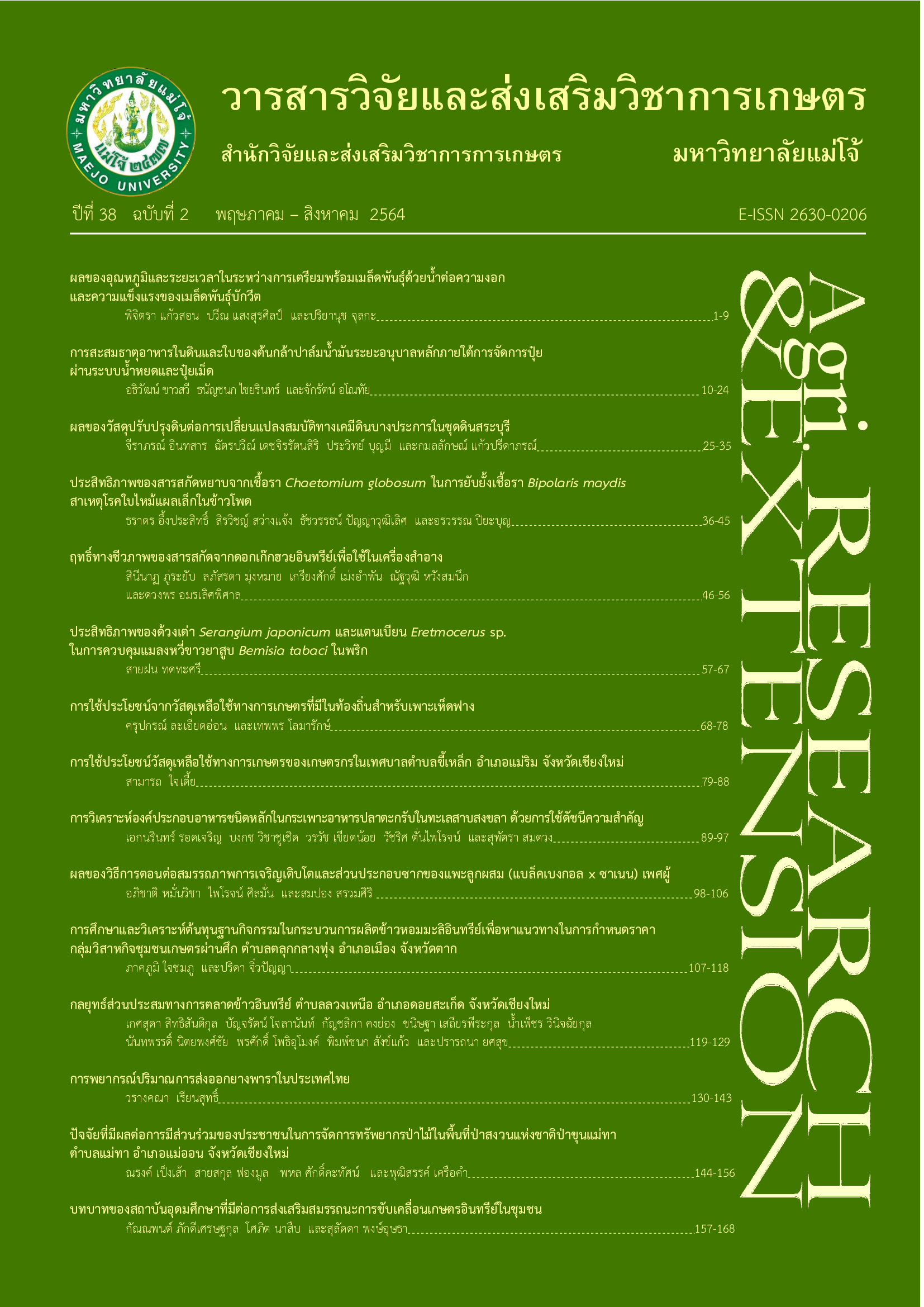ประสิทธิภาพของสารสกัดหยาบจากเชื้อรา Chaetomium globosum ในการยับยั้งเชื้อรา Bipolaris maydis สาเหตุโรคใบไหม้แผลเล็กในข้าวโพด
คำสำคัญ:
สารสกัดหยาบ, วิธีการเลี้ยงเชื้อร่วมกัน, เปอร์เซ็นต์การยับยั้งการเจริญของเส้นใย, โรคใบไหม้บทคัดย่อ
เชื้อรา Bipolaris เป็นเชื้อราที่ก่อโรคใบไหม้ในข้าวโพดทำให้ลดการสังเคราะห์ด้วยแสงของข้าวโพด และสร้างความสูญเสียแก่ผลผลิตที่สำคัญในประเทศไทย การใช้ชีววิธีในการควบคุมโรคพืชโดยเฉพาะการใช้เชื้อรา Chaetomium globosum มีศักยภาพในการควบคุม เชื้อราก่อโรคต่างๆ การศึกษานี้มีวัตถุประสงค์เพื่อศึกษาประสิทธิภาพการยับยั้งเชื้อรา B. maydis ด้วยเชื้อรา C. globosum และประสิทธิภาพของสารสกัดหยาบจากเชื้อรา C. globosum ในการยับยั้งเชื้อรา B. maydis ภายใต้สภาพห้องปฏิบัติการและสภาพโรงเรือน วิธีทดลองแรกเป็นการเลี้ยงเชื้อรา B. maydis และ C. globosum และทดสอบประสิทธิภาพของสารสกัดหยาบจากเชื้อรา C. globosum ในการยับยั้งเชื้อรา B. maydis ภายใต้ห้องปฏิบัติการด้วยวิธีการเลี้ยงเชื้อร่วมกัน ผลการศึกษาพบว่าเปอร์เซ็นต์การยับยั้งการเจริญของเส้นใยเชื้อรา B. Maydis ของเชื้อรา C. globosum มีค่าเท่ากับ 51.16% หลังจากนั้นนำเชื้อรา C. globosum มาสกัดด้วยตัวทำละลายเมทานอลและเอทิลอะซิเตท และนำสารสกัดหยาบจากเชื้อรา C. globosum มาทดสอบการยับยั้ง เชื้อรา B. maydis ภายใต้ห้องปฏิบัติการและสภาพโรงเรือน โดยพบว่าสารสกัดหยาบจากเชื้อรา C. globosum ความเข้มข้นที่ 7,000, 3,500 และ 1,750 ไมโครกรัมต่อมิลลิลิตร สามารถยับยั้งเชื้อรา B. maydis ที่เป็นเชื้อสาเหตุโรคใบไหม้แผลเล็กในข้าวโพด
เอกสารอ้างอิง
Amemiya, Y., A. Kondo, T. Hirukawa and T. Kato. 1994. Antifungal bubstrances produced by Chaetomium globosum. Technical Bulletin of Faculty of Hortriculture, Chiba University 48: 13-18.
Ashwini, C. 2019. A review on Chaetomium globosum is versatile weapons for various plant pathogens. Journal of Pharmacognosy and Phytochemistry 8(2): 946-949.
Chang, I. and T. Kommedahl. 1968. Biological control of seedling blight of corn by coating kernels with antagonistic microorganisms. Phytopathology 58: 1395-1401.
Kamal, L. and S.N. Mathur. 2005. Cellulolytic activities of Chaetomium globosum on different cellulosic substrates. World Journal of Microbiology and Biotechnology 5(1): 23-26.
Kumar, S., N. Kaushik and P. Proksch. 2013. Identification of antifungal principle in the solvent extract of an endophytic fungus Chaetomium globosum from Withania somnifera. SpringerPlus 2(37): 2-10.
Office of the Permantent Secretary for Ministry of Agriculture and Cooperatives. 2020. Fodder corn. [Online]. Available https://www.opsmoac.go.th/saraburi-dwl-files-412791791798 (4 September 2020). [in Thai]
Piyaboon, O., R. Pawongrat, J. Unartngam, A. Chinawong and A. Unartngam. 2016. Pathogenicity, host range and activities of a secondary metabolite and enzyme from Myrothecium roridum on water hyacinth from Thailand. Weed Biology and Management 16: 132-144.
Pelo, S., V. Mavumengwana and E. Green. 2020. Diversity and antimicrobial activity of culturable fungal endophytes in Solanum mauritianum. International Journal of Environmental Research and Public Health 17(439): 2-11.
Prommate, A., S. Valyasevi, H. Arunothayanan, R.J. McGovern, R. Cheewankoon and C. To-anun. 2019. Antagonistic activities of Chaetomium spp. on Phytophthora palmivora (P-05) from durian root and stem rot. Khon Kaen Agriculture Journal 47(6): 1251-1264.
Rungprom, W., S. Sawatdikarn and S. Siripornvisaln. 2008. Bioactive compounds from Garcinia xanthochymas against Biopolaris oryzae the cause of brown spot disease in rice. Agricultural Science Journal 39(3): 512-515.
Shanthiya, V., D. Saravanakumar, G. Rajendran, G. Karthikeyan, K. Prabakar, T. Raguchander. 2013. Use of Chaetomium globosum for biocontrol of potato late blight disease. Crop protection 52: 32-38.
Sleesman, J.P. and L. Curt. 1976. Microbial antagonists of Bipolaris maydis. Phytopathology 66: 1214-1218.
Sorensen, H. 1952. On the specificity and products of action of xylanase from Chaetomium globosum Kunze. Physiologia Plantarum 5(2): 183-198.
Soytong, K., W. Srinon, K. Rattanacherdchai, S. Kanokmedhakul and K. Kanokmedhakul. 2005. Application of antagonistic fungi to control anthracnose disease of grape. Journal of Agricultural Biotechnology 1: 33-41.
Sun, X., X. Qi, W. Wang, X. Liu, H. Zhao, C. Wu, X. Chang, M. Zhang, H. Chen and G. Gong. 2020. Etiology and symptoms of maize leaf spot caused by Bipolaris spp. in Sichuan, China. Pathogens 9(3): 1-18.
ดาวน์โหลด
เผยแพร่แล้ว
รูปแบบการอ้างอิง
ฉบับ
ประเภทบทความ
สัญญาอนุญาต
ลิขสิทธิ์ (c) 2021 วารสารวิจัยและส่งเสริมวิชาการเกษตร

อนุญาตภายใต้เงื่อนไข Creative Commons Attribution-NonCommercial-NoDerivatives 4.0 International License.
บทความนี้ได้รับการเผยแพร่ภายใต้สัญญาอนุญาต Creative Commons Attribution-NonCommercial-NoDerivatives 4.0 International (CC BY-NC-ND 4.0) ซึ่งอนุญาตให้ผู้อื่นสามารถแชร์บทความได้โดยให้เครดิตผู้เขียนและห้ามนำไปใช้เพื่อการค้าหรือดัดแปลง หากต้องการใช้งานซ้ำในลักษณะอื่น ๆ หรือการเผยแพร่ซ้ำ จำเป็นต้องได้รับอนุญาตจากวารสาร





